

A Simple Way to Create Suspense - NYTimes.com - Nightly. Draft is a series about the art and craft of writing.
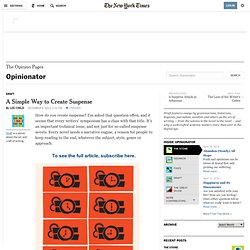
How do you create suspense? I’m asked that question often, and it seems that every writers’ symposium has a class with that title. It’s an important technical issue, and not just for so-called suspense novels. Every novel needs a narrative engine, a reason for people to keep reading to the end, whatever the subject, style, genre or approach. But it’s a bad question. Because “How do you create suspense?” So writers are taught to focus on ingredients and their combination. But it’s really much simpler than that. And the answer is: You make them wait four hours for dinner. As novelists, we should ask or imply a question at the beginning of the story, and then we should delay the answer. Brandon Schaefer Readers are human, and humans seem programmed to wait for answers to questions they witness being asked.
(You notice I haven’t told you what the invention was yet? So how did we respond? We knew most viewers would be intrigued. Pablo eCasso? In search of the first computer masterpiece - Nightly. For much of his adult life, painter and scholar Harold Cohen has been working in collaboration with a computer to make visual art.
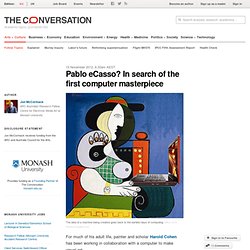
Cohen has worked almost continuously on this creative artificial intelligence (AI) system since the 1970s, which he affectionately calls AARON. In essence, AARON is a piece of computer software that, when connected to a painting machine – a large-scale inkjet printer these days – can create artworks based on instructions given by Cohen. Over the years AARON’s artistic style has matured, much like that of a human artist. The earliest images were simple drawings “exploring the line” as a young child learning to draw might do. Gradually the images became more figurative, incorporating people, trees and complex shapes. The works are received and appreciated as fine art, and regularly exhibited at major galleries in the US and Europe. Cohen’s work has caused much philosophical debate about the possibility of computer creativity. Kurt Vonnegut on the Shapes of Stories and Good News vs. Bad News.
“The truth is, we know so little about life, we don’t really know what the good news is and what the bad news is.”
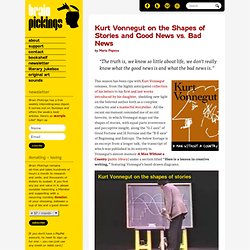
This season has been ripe with Kurt Vonnegut releases, from the highly anticipated collection of his letters to his first and last works introduced by his daughter, shedding new light on the beloved author both as a complex character and a masterful storyteller. All the recent excitement reminded me of an old favorite, in which Vonnegut maps out the shapes of stories, with equal parts irreverence and perceptive insight, along the “G-I axis” of Good Fortune and Ill Fortune and the “B-E axis” of Beginning and Entropy. The below footage is an excerpt from a longer talk, the transcript of which was published in its entirety in Vonnegut’s almost-memoir A Man Without a Country (public library) under a section titled “Here is a lesson in creative writing,” featuring Vonnegut’s hand-drawn diagrams. Humanity’s last invention and our uncertain future - Research - University of Cambridge - Nightly.
In 1965, Irving John ‘Jack’ Good sat down and wrote a paper for New Scientist called Speculations concerning the first ultra-intelligent machine.

Good, a Cambridge-trained mathematician, Bletchley Park cryptographer, pioneering computer scientist and friend of Alan Turing, wrote that in the near future an ultra-intelligent machine would be built. This machine, he continued, would be the “last invention” that mankind will ever make, leading to an “intelligence explosion” - an exponential increase in self-generating machine intelligence. For Good, who went on to advise Stanley Kubrick on 2001: a Space Odyssey, the “survival of man” depended on the construction of this ultra-intelligent machine.
Fast forward almost 50 years and the world looks very different. “Nature didn’t anticipate us, and we in our turn shouldn’t take AGI for granted. “He (Tallinn) said that in his pessimistic moments he felt he was more likely to die from an AI accident than from cancer or heart disease. Electronic Music Interfaces - Nightly. © Portions copyright March 1998 by Joseph A.
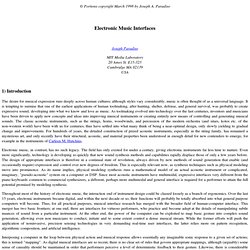
Paradiso Electronic Music Interfaces Joseph Paradiso MIT Media Laboratory20 Ames St. E15-325Cambridge MA 02139USA. American Innovations in Electronic Musical Instruments - Nightly. The desire for musical expression runs deeply across human culture; although specific styles can vary, music is generally considered a universal language.

It is tempting to surmise that one of the earliest applications of human toolmaking, after hunting, shelter, defense, and general survival, was probably to create expressive sound, developing into what we know and love as music. As toolmaking evolved into technology over the last centuries, inventors and musicians have been driven to apply new concepts and ideas into improving musical instruments or creating entirely new means of controlling and generating musical sounds. The classic acoustic instruments, such as the strings, horns, woodwinds, and percussion of the modern orchestra and others of the non-western world have been with us for centuries, thus have settled into what many think of being a near-optimal design, only slowly yielding to gradual change and improvements. How To Approach A Poem - Nightly. Here, The Muse Of Literature offers a method, a practical example, and a few suggestions for how to get the most from reading or hearing a poem.

About this feature The aim of this feature is to provide a few pointers to people who want to better understand and experience a poem when they approach it. Poetic analysis Why bother to analyze poetry? The Long, Weird History of Photo Manipulation. While "to Photoshop" is now synonymous with altering a photograph with intent to deceive, this not only pre-dates our digital era but can be traced back to the early years of photography itself.
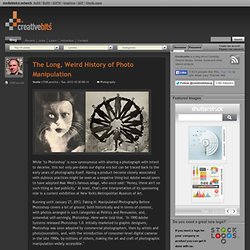
Having a product become closely associated with dubious practices might be seen as a negative thing but Adobe would seem to have adopted Mae West's famous adage, who once said: "Honey, there ain't no such thing as bad publicity. " Fanfare for the Comma Man - NYTimes.com - Nightly. Draft is a series about the art and craft of writing. Is it safe to talk about punctuation again? Eight years ago, Lynne Truss’s best-selling “Eats, Shoots & Leaves” took, in the words of her subtitle, a “Zero Tolerance Approach” to the subject. Although Truss’s focus on errors drew the ire, if not the fire, of grammarians, linguists and other “descriptivists,” her book was, for the most part, harmless and legitimate. Still, it overlooked a lot. Maybe more than any other element of writing, punctuation combines rules with issues of sound, preference and personal style. The two big players in the field are the period and the comma.
The Sentence as a Miniature Narrative - NYTimes.com - Nightly. A Picture of Language - NYTimes.com - Nightly. What Can We Learn From Diagramming Sentences? - NYTimes.com - Nightly. Draft is a series about the art and craft of writing.
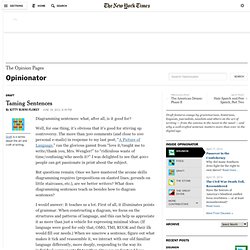
Diagramming sentences: what, after all, is it good for? Well, for one thing, it’s obvious that it’s good for stirring up controversy. The more than 300 comments (and close to 100 personal e-mails) in response to my last post, “A Picture of Language,” ran the glorious gamut from “love it/taught me to write/thank you, Mrs. Using Words Not Found in the Dictionary - NYTimes.com - Nightly. Draft is a series about the art and craft of writing.
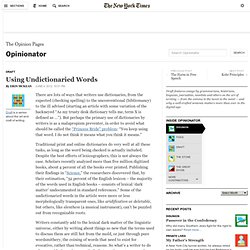
There are lots of ways that writers use dictionaries, from the expected (checking spelling) to the unconventional (bibliomancy) to the ill advised (starting an article with some variation of the hackneyed “As my trusty desk dictionary tells me, term X is defined as …”). But perhaps the primary use of dictionaries by writers is as a malapropism preventer, in order to avoid what should be called the “Princess Bride” problem: “You keep using that word. I do not think it means what you think it means.” Traditional print and online dictionaries do very well at all these tasks, as long as the word being checked is actually included.
Talking With Your Fingers - NYTimes.com - Nightly. Draft is a series about the art and craft of writing. The latest word on the street about English in America – always bad, it seems – is that the shaggy construction of texting and e-mail spells the death of formal writing. Yet the truth about English in America – always sunnier, in fact – is that the looseness and creativity of these new ways of writing are a sign of a new sophistication in our society. This becomes clear when we understand that in the proper sense, e-mail and texting are not writing at all. Historical perspective is useful. The Pleasures and Perils of the Passive - NYTimes.com - Nightly. Draft is a series about the art and craft of writing. This is the fourth in a series of writing lessons by the author, starting with the basics and leading to more advanced techniques. The word passive gets a bad rap. We throw it around to vent about friends who can’t stand up for themselves, and we combine it with aggressive to describe those who express anger indirectly rather than just blurting it out.
When it comes to writing, many of us are haunted by this word. Maybe a high school teacher forbade “passive constructions.” There is certainly some merit to this rule of thumb; some of the worst writing around suffers from inert verbs and the unintended use of the passive voice. Turning a Phrase - NYTimes.com - Nightly. Draft is a series about the art and craft of writing. This is the fifth in a series of writing lessons by the author, starting with the basics and leading to more advanced techniques. Writers dream of sentences that sail through the waters of thought. Grammar: A Matter of Fashion - NYTimes.com - Nightly. Draft is a series about the art and craft of writing. “Much was said, and much was ate, and all went well.” Clearly this sentence was written by a fourth grader – or at best someone not ushered into acquaintance with “proper” grammar.
Like, say, Jane Austen? DRAFT - Opinionator - NYTimes.com - Nightly. John Wells and I have been together a very long time. If you haven’t heard of Wells, he’s a C.I.A. operative who plays the starring role in a series of espionage thrillers that I started writing a decade ago. Random House published the first, “The Faithful Spy,” in 2006. I planned to kill Wells off at its end, a la John le Carre’s Alec Leamas. But my editor told me I couldn’t end with a fade to black, that I’d have to have a funeral. I found I couldn’t write the scene. Which Language and Grammar Rules to Flout - Room for Debate - NYTimes.com - Nightly.
The Proliferation of Verbifications - NYTimes.com - Nightly. Can an Algorithm Write a Better News Story Than a Human Reporter? Had Narrative Science — a company that trains computers to write news stories—created this piece, it probably would not mention that the company’s Chicago headquarters lie only a long baseball toss from the Tribune newspaper building. Nor would it dwell on the fact that this potentially job-killing technology was incubated in part at Northwestern’s Medill School of Journalism, Media, Integrated Marketing Communications. Those ironies are obvious to a human. But not to a computer. At least not yet. Can an Algorithm Write a Better News Story Than a Human Reporter? Mad Dash: How to Use the Dash in Writing - NYTimes.com - Nightly. Ash Cloud Tales - Nightly. On Wikipedia, Cultural Patrimony, and Historiography. On Friday, I spoke at dConstruct in Brighton.
Nothing found for 2010 09 07 Wikipedia-as-historiography - Nightly. The Iraq War: A Wikipedia Historiography - a set on Flickr - Nightly. Network Realism: William Gibson and new forms of Fiction. I recently spoke at Web Directions South in Sydney, which was a lot of fun. I was invited to talk about the future of the book, and I did… sort of. In this post, I want to expand on some of the thoughts in that talk, which tied together a common thread from several previous discussions, and see if I can do some old-fashioned lit crit too. Booktwo.org - Nightly. Earlier today, I gave a talk at The Space Between Us, the conference of the National Association of Literature Development. Opinions are non-contemporary. The internet considered as a fifth dimension, that of memory. Let’s do some rambling. 211, William Gibson - Nightly. Living inside the Machine.
Simon Norfolk - Nightly. Booktwo.org - Nightly. The Key to Media's Hidden Codes - Nightly.
Bite my manifesto - Nightly. Something like a manifesto « Municipal Archive - Nightly. Municipal Archive - Nightly. The official field guide to serious funUNBORED. Kio Stark - Nightly. International Law. A Treatise. Volume II (of 2) by L. Oppenheim. Rhetoric and Composition - Wikibooks, open books for an open world - Nightly. Freud on Creative Writing and Daydreaming. Resource Intensity of Cities - Nightly. When Test Scores Become a Commodity. Who wants an open source curriculum based Education? Two Methods of Instruction - Andrew Kern. Writer's Diet. A blog on music cognition. The Point of Exclamation. The Chicago Manual of Style Online: Chapter 1 Contents. 8. Nominalizations Are Zombie Nouns. The Sound of a Sentence. Writing with Ease.
Unsorted 4. Unsorted 1. Unsorted 5. School as Wonder, or Way Out. Resources. Unsorted 7. Unsorted 8. Unsorted 9. Unsorted 10. Unsorted 11. Unsorted 12. Unsorted 13. Unsorted 14. Teaching. Online Lang and Lit. Listening. Listen and Write - Dictation. VILC. Alone in the Void.